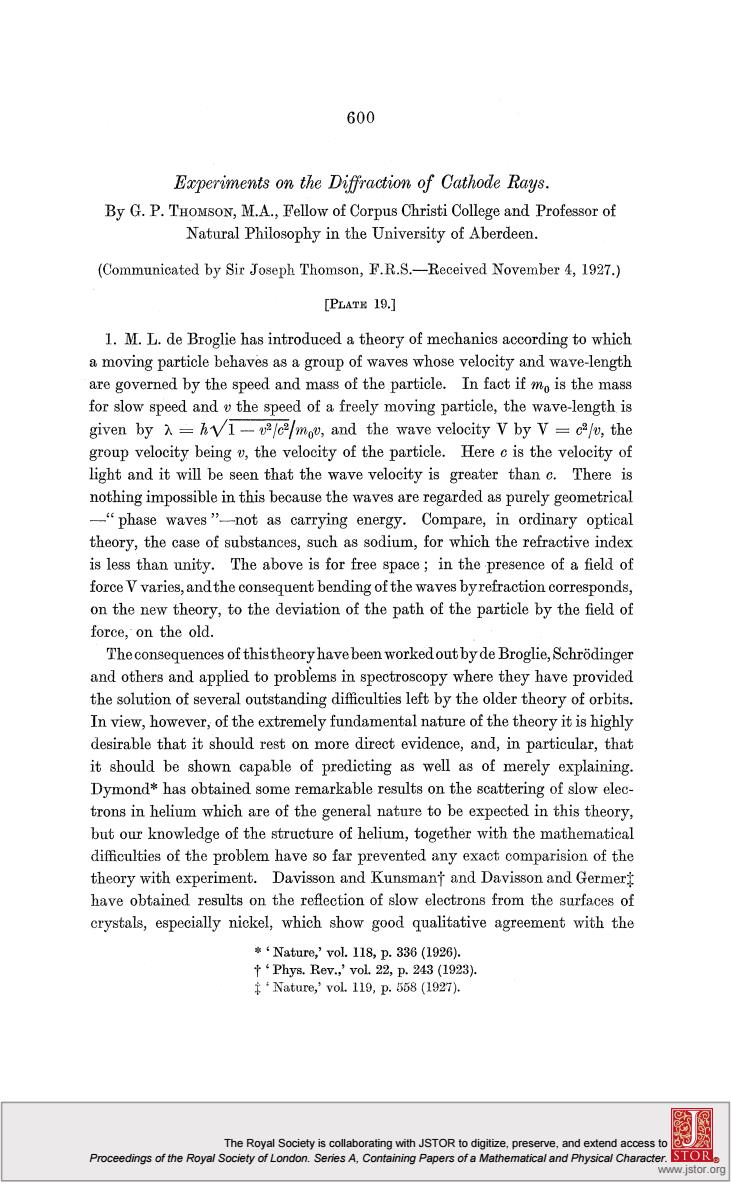
600 Experiments on the Diffraction of Cathode Rays. By G.P.THOMSON,M.A.,Fellow of Corpus Christi College and Professor of Natural Philosophy in the University of Aberdeen (Communicated by Sir Joseph Thomson,F.R.S.-Received November 4,1927.) [PLATH 19.] 1.M.L.de Broglie has introduced a theory of mechanics according to which a moving particle behaves as a group of waves whose velocity and wave-length are governed by the speed and mass of the particle.In fact if mo is the mass for slow speed and the speed of a freely moving particle,the wave-length is given by =hv1-2/c2/mov,and the wave velocity V by V=calv,the group velocity being v,the velocity of the particle.Here c is the velocity of light and it will be seen that the wave velocity is greater than c.There is nothing impossible in this because the waves are regarded as purely geometrical -"phase waves"-not as carrying energy.Compare,in ordinary optical theory,the case of substances,such as sodium,for which the refractive index is less than unity.The above is for free space;in the presence of a field of force V varies,and the consequent bending of the waves byrefraction corresponds, on the new theory,to the deviation of the path of the particle by the field of force,on the old. The consequences of thistheory have been workedout by de Broglie,Schrodinger and others and applied to problems in spectroscopy where they have provided the solution of several outstanding difficulties left by the older theory of orbits. In view,however,of the extremely fundamental nature of the theory it is highly desirable that it should rest on more direct evidence,and,in particular,that it should be shown capable of predicting as well as of merely explaining. Dymond*has obtained some remarkable results on the scattering of slow elec- trons in helium which are of the general nature to be expected in this theory, but our knowledge of the structure of helium,together with the mathematical difficulties of the problem have so far prevented any exact comparision of the theory with experiment.Davisson and Kunsmanf and Davisson and Germer have obtained results on the reflection of slow electrons from the surfaces of crystals,especially nickel,which show good qualitative agreement with the *‘Nature,.'vol.118,p.336(1926). ↑‘Phys.Rev.,'vol.22,p.243(1923). 年Nature,'voL.119,p.558(1927. The Royal Society is collaborating with JSTOR to digitize,preserve,and extend access to Proceedings of the Royal Society of London.Series A.Containing Papers of a Mathematical and Physical Character. www.jstor.org
The Royal Society is collaborating with JSTOR to digitize, preserve, and extend access to Proceedings of the Royal Society of London. Series A, Containing Papers of a Mathematical and Physical Character. www.jstor.org ®

Eperiments on Diffraction of Cathode Rays. 60] theory but a discrepancy of 30 per cent.in certain magnitudes.It is hoped that the experiments described in this paper will advance the matter a stage further.They are a development of some experiments of which a preliminary account appeared recently in 'Nature.'* 2.These experiments were begun last year with the idea of extending Dymond's experiments on scattering to solid films and faster electrons,where it seemed probable that the technique developed for dealing with positive ray- scattering could be applied with advantage.The results now obtained,how- ever,are best looked at from a slightly different point of view to that applicable to Dymond's work,namely,as follows. On the de Broglie theory the electron is considered as a group of waves and its motion through matter is determined by considerations of scattering and diffraction.For electrons of 25,000 volts energy the wave-length a calculated from the above formula is about 0.75 x 10-9 cm.This is of the order of that of hard X-rays and the waves associated with electrons of this energy should behave in many respects like hard X-rays.In fact on this view there is a very close analogy between the two.The quantum effects of X-rays are regarded as due to centres of energy guided by waves,while in the case of the electrons the motion of the electric charge,in which the energy is centred,is regarded as taking place along the rays of the group of phase waves associated with it.In particular the electrons should show diffraction effects when passed through a crystal identical with those shown by X-rays of the same wave-length.It is, perhaps,hardly necessary to say that this does not mean that the two are indistinguishable.Unlike X-rays the electrons are deflected by electric and magnetic fields.They carry a charge,and for equal wave-lengths,have much less energy and less penetrating power. 3.In essence the experiments to be described consist in sending a beam of approximately homogeneous cathode rays through a very thin film at normal incidence and receiving them on a photographic plate some distance behind. If the film consists of a number of minute crystals arranged at random we should get a pattern identical with that obtained in a Hull-Debye-Scherrer apparatus with X-rays of the same wave-length.If certain directions of crystal predomi- nate the pattern will be modified in a calculable manner.It will be seen below that both these cases have been found.The only other necessary condition is that the film shall be so thin that the electron in its passage through it is only scattered once,otherwise the pattern will be hopelessly blurred by the super- position of the deflections and will appear on the photographic plates as a Thomson and Reid,'Nature,'vol.119,p.890 (1927)
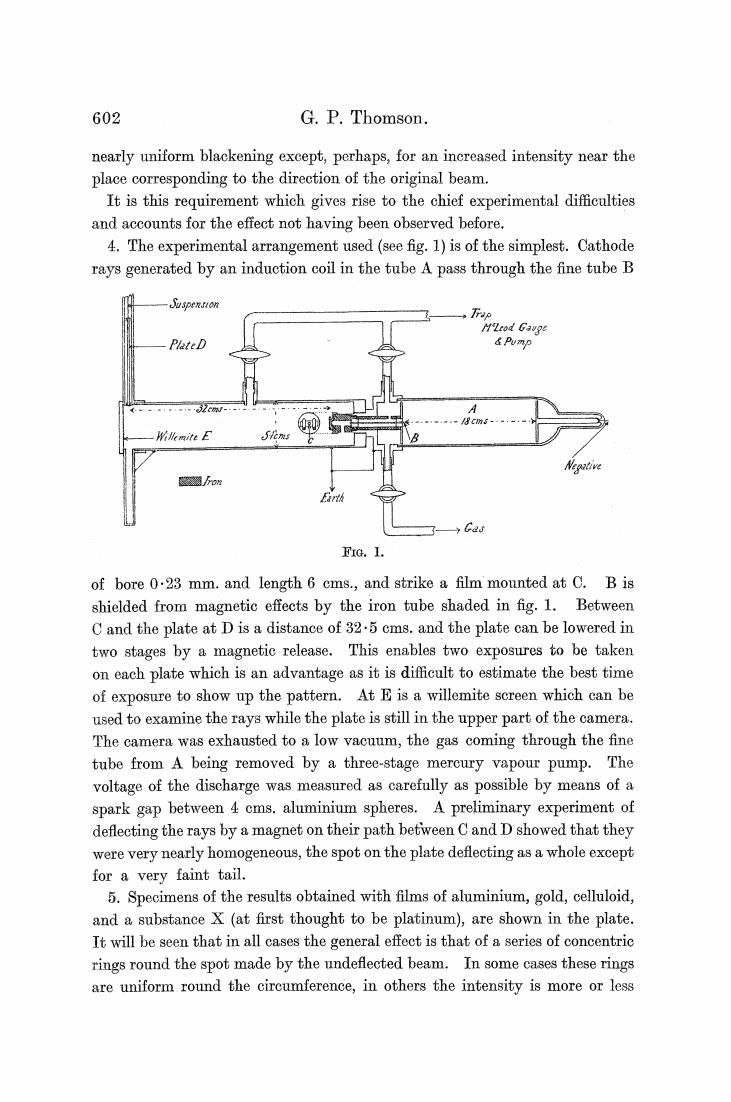
602 G.P.Thomson. nearly uniform blackening except,perhaps,for an increased intensity near the place corresponding to the direction of the original beam. It is this requirement which gives rise to the chief experimental difficulties and accounts for the effect not having been observed before. 4.The experimental arrangement used (see fig.1)is of the simplest.Cathode rays generated by an induction coil in the tube A pass through the fine tube B -Syspension .Trap MLod Gauge PlateD Pump 00 所肠两eE Eron Cas FIG.1. of bore 0.23 mm.and length 6 cms.,and strike a film mounted at C.B is shielded from magnetic effects by the iron tube shaded in fig.1.Between C and the plate at D is a distance of 32.5 cms.and the plate can be lowered in two stages by a magnetic release.This enables two exposures to be taken on each plate which is an advantage as it is difficult to estimate the best time of exposure to show up the pattern.At E is a willemite screen which can be used to examine the rays while the plate is still in the upper part of the camera. The camera was exhausted to a low vacuum,the gas coming through the fine tube from A being removed by a three-stage mercury vapour pump.The voltage of the discharge was measured as carefully as possible by means of a spark gap between 4 cms.aluminium spheres.A preliminary experiment of deflecting the rays by a magnet on their path between C and D showed that they were very nearly homogeneous,the spot on the plate deflecting as a whole except for a very faint tail. 5.Specimens of the results obtained with films of aluminium,gold,celluloid, and a substance X (at first thought to be platinum),are shown in the plate. It will be seen that in all cases the general effect is that of a series of concentric rings round the spot made by the undeflected beam.In some cases these rings are uniform round the circumference,in others the intensity is more or less
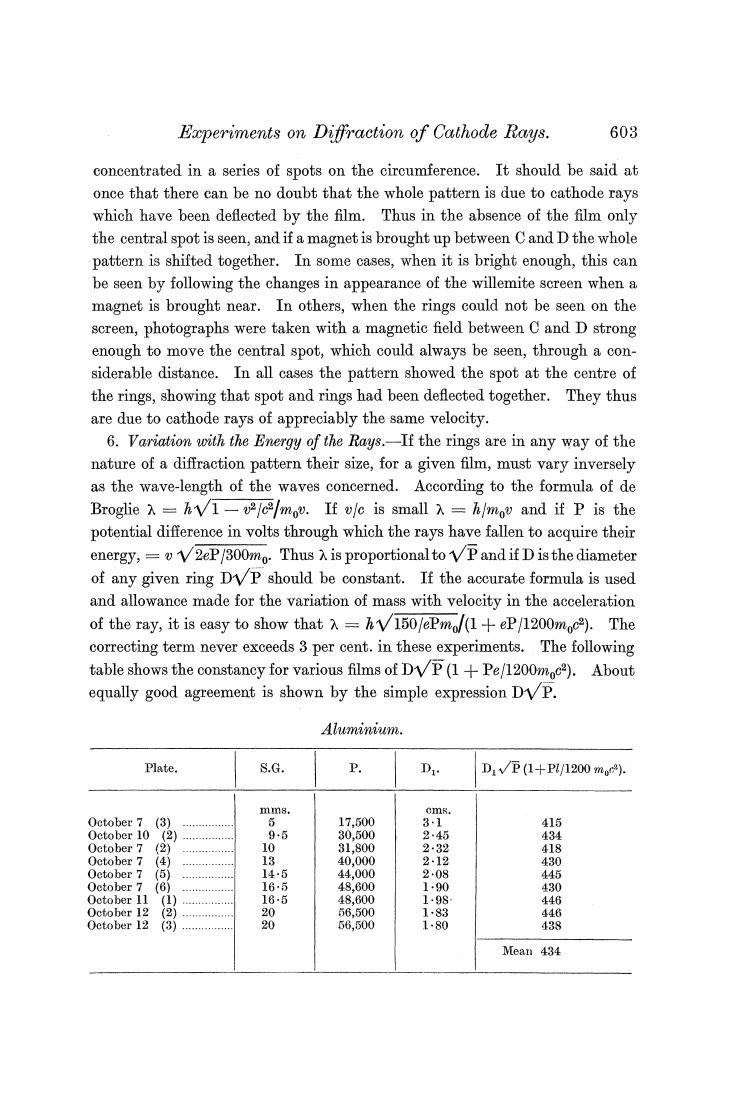
Eperiments on Diffraction of Cathode Rays. 603 concentrated in a series of spots on the circumference.It should be said at once that there can be no doubt that the whole pattern is due to cathode rays which have been deflected by the film.Thus in the absence of the film only the central spot is seen,and if a magnet is brought up between C and D the whole pattern is shifted together.In some cases,when it is bright enough,this can be seen by following the changes in appearance of the willemite screen when a magnet is brought near.In others,when the rings could not be seen on the screen,photographs were taken with a magnetic field between C and D strong enough to move the central spot,which could always be seen,through a con- siderable distance.In all cases the pattern showed the spot at the centre of the rings,showing that spot and rings had been deflected together.They thus are due to cathode rays of appreciably the same velocity. 6.Variation with the Energy of the Rays.-If the rings are in any way of the nature of a diffraction pattern their size,for a given film,must vary inversely as the wave-length of the waves concerned.According to the formula of de Broglie =hv1-v2/c/mov.If vfc is small =h/mov and if P is the potential difference in volts through which the rays have fallen to acquire their energy,=V2eP/300mo Thus is proportionaltoVPand if D isthe diameter of any given ring DVP should be constant.If the accurate formula is used and allowance made for the variation of mass with velocity in the acceleration of the ray,it is easy to show that=150/ePmo/(1+eP/1200moc2).The correcting term never exceeds 3 per cent.in these experiments.The following table shows the constancy for various films of DVP(1+Pe/1200mc). About equally good agreement is shown by the simple expression DP. Aluminium. Plate. 8.G. P. Dt D1√E(1+P/1200mo). October 7 (3 含 17.500 31 415 October 10 e 9-5 30,500 245 434 Oetober 7 10 31,800 232 418 Oetober 7 (4) 13 40,000 2-12 430 October 7 (5 -+k=t+=n44+ 145 44,000 2-08 445 October 7 165 48.600 1-90 430 October 11 (1) 16-5 48,600 1-98 446 October 12 e 20 66,500 1-83 446 October 12 年年年 2 56,500 1.80 438 Mean 434

604 G.P.Thomson. Gold. Plate. S.G. P D D'√P(1+Pe/100moc). mms. cms October 13 (1) …小… 75 24.600 2,50 398 Oetober 12 (4) 10 31,800 2·15 390 October 12 (5) 12.75 39,400 2-00 404 October 12 (6) 15·25 45,600 1·86 405 October 12 (7) 54,300 163 388 October 17 61,200 161 410 Mean 399 This close agreement is in itself strong evidence for the de Broglie theory, and justifies us in considering in detail the other consequences to be expected on this view. 7.Suppose that a beam of cathode rays is incident at an angle 0 on a plane of indices (k)of a small element of crystal.According to the Bragg formula it will be reflected provided that 2d sin 0=aA,where d is the spacing between parallel planes of the type ()If L is the distance of the plate,this will give rise to a mark on the plate at a distance D/2 from the central spot where D=4 0L=2n AL/d,assuming 0 is small. If a large number of small crystals are present arranged at random so that some are present at all angles we shall have a ring of diameter given by the above formula for every spacing d in the 02 crystal lattice and n=1,2,3,ete.This Primary Beam is,of course,the well-known Hull-Debye- F1G.2. Scherrer pattern for powdered crystals. If the crystals have definite orientations with respect to the film some of these rings will be absent.Thus consider a crystal with rectangular axes and suppose a (1,0,0)face is always (approximately)parallel to the film surface,we shall have reflections from (0,1,0)and (0,1,1)faces because the small angle 0 required can be provided by the slight divergence of the cathode ray beam,and by lack of flatness in the film.On the other hand the reflection from(1,1,1)will not appear because the rays would have to make a large angle with the plane of the film in order to be incident on (1,1,1)at the small angle required by the law 2 d sin 0=nA remembering that is of the order of 1/50 that of d.If,further,the crystals are so orientated that not merely is one axis perpendicular to the film,but the
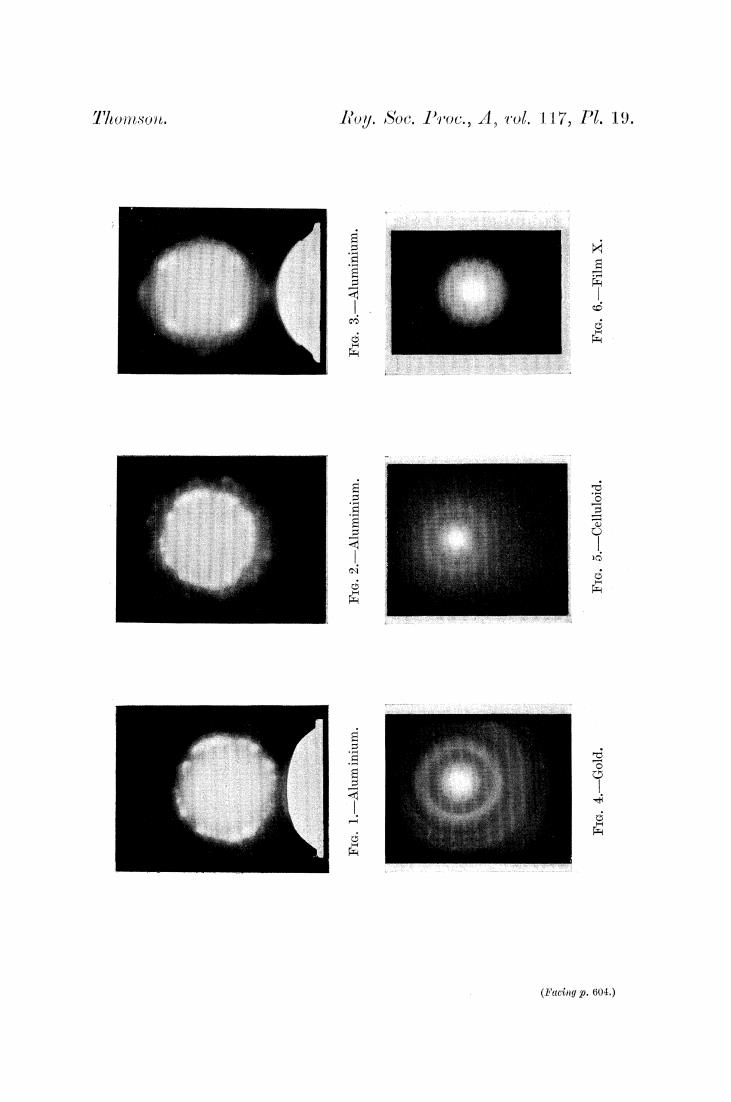
Thomson. Roy.Soc.Proc.,A,rol.117,Pl.19. wnruwnF-'8 'I 'wnruywn/y-3'SI promnl- 'wmnyuy u-'I '1 por-6.01 (F'ucing p.604.)

Experiments on Diffraction of Cathode Rays. 605 axes in the film are not arranged at random,then the rings which do appear will not be of uniform intensity,each direction of the axes giving rise,in the case of cubic symmetry,to four spots on the circumference of the ring. 8.Aluminiwm.-Let us examine the results obtained with aluminium from this point of view.The films used were the thinnest foil etched down by floating in caustic potash till they were transparent.It is difficult to estimate the thickness actually used as the films so formed are not uniform,but probably to give good results they must not be more than 10-5 cm.Looking at figs.1 and 2(Plate 19),we see that the rings are non-uniform so that presumably the crystals have become orientated in the process of rolling the film.Besides the inner ring Di,two others,D2 and Ds:can be distinguished outside it,and traces of a fourth between D2 and Da. The ratios of D./D,Da/D,are shown below. Plate. 0ct.12 0ct.11 0ct.7 0ct.7 0ct.7 0ct.7 0ct.7 Mean. (3). (1). (6). (5). (2) (2). (1). D./D 141 1.39 142 137 1.38 142 141 140 D:/D 2-15 2-02 2-08 In some of the cases in which no value of Da/D,is given the ring was outside the field on view,in some it was too faint to measure.It will be seen that the ratios correspond closely to√2:land2:l. Now aluminium is found from X-ray experiments to have a fore-centred cubic lattice.For such a lattice the distances "d"of the planes are given by d=a√+2+2 where五,k,I are the indices of the plane and“a”the side of the unit cube.If some of the quantities(亿,,)are odd and some even,. counting zero even,all are to be doubled. Now,if one axis is perpendicular to the film,the possible planes are those for which one index is zero,and the smallest values of k,l are (1,0,0),(1,1,0), (1,2,0),etc.Now D=2nLVa,hence doubling the indices when required we have in succession Da/xL=n4,n412,n4V5,etc.If we put n=1,2in the first and n=2 in the second,we get Da/L=4,4V2,8 or in the ratio 1:V2:2 as found for D1:Da:Da and it is easy to see that any other ring will be outside these.The faint ring between Da and Ds is, I think,probably due to a few of them not being orientated in the way assumed.As far as can be measured its diameter is to D,as V3:1 and thus would correspond to the second order reflection from a(1,1,1)plane. In the examples reproduced there are too many crystals,as shown by the *Da is not visible in the reproductions. VOL.CXVII.一A. 2T
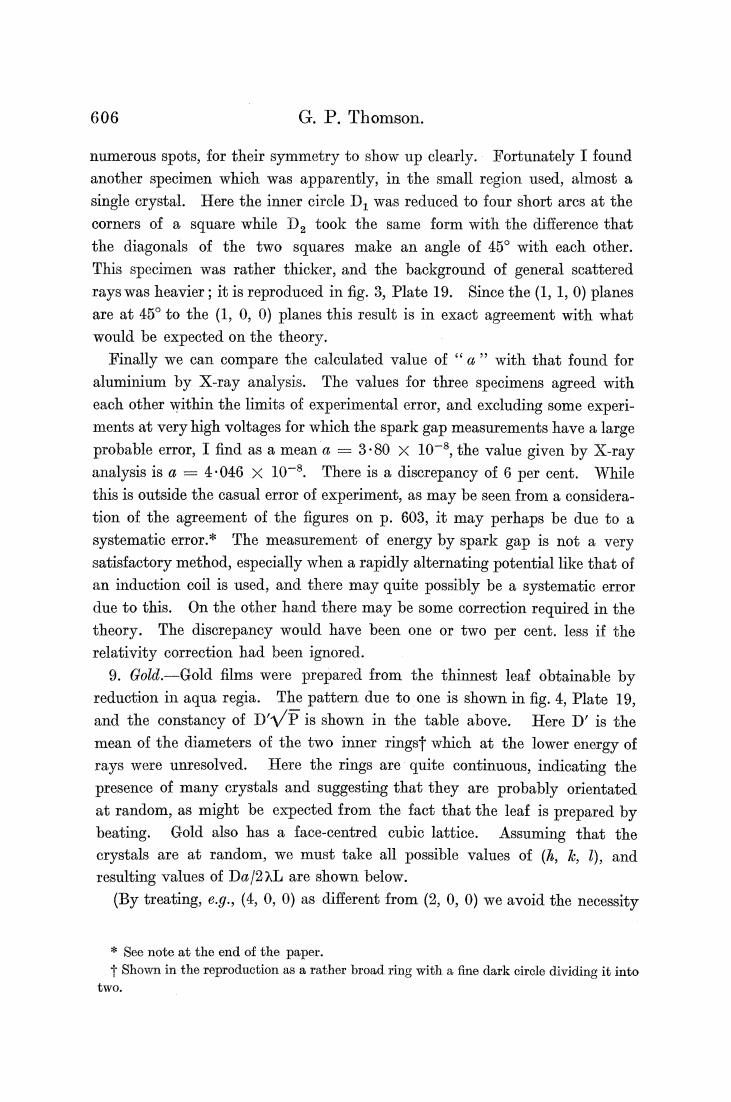
606 G.P.Thomson. numerous spots,for their symmetry to show up clearly.Fortunately I found another specimen which was apparently,in the small region used,almost a single crystal.Here the inner circle D,was reduced to four short arcs at the corners of a square while D2 took the same form with the difference that the diagonals of the two squares make an angle of 45 with each other. This specimen was rather thicker,and the background of general scattered rays was heavier;it is reproduced in fig.3,Plate 19.Since the (1,1,0)planes are at 45 to the (1,0,0)planes this result is in exact agreement with what would be expected on the theory. Finally we can compare the calculated value of"a"with that found for aluminium by X-ray analysis.The values for three specimens agreed with each other within the limits of experimental error,and excluding some experi- ments at very high voltages for which the spark gap measurements have a large probable error,I find as a mean a =3.80 x 10-8,the value given by X-ray analysis is a =4.046 x 10-8.There is a discrepancy of 6 per cent.While this is outside the casual error of experiment,as may be seen from a considera- tion of the agreement of the figures on p.603,it may perhaps be due to a systematic error.*The measurement of energy by spark gap is not a very satisfactory method,especially when a rapidly alternating potential like that of an induction coil is used,and there may quite possibly be a systematic error due to this.On the other hand there may be some correction required in the theory.The discrepancy would have been one or two per cent.less if the relativity correction had been ignored. 9.Gold.-Gold films were prepared from the thinnest leaf obtainable by reduction in aqua regia.The pattern due to one is shown in fig.4,Plate 19, and the constancy of D'vP is shown in the table above.Here D'is the mean of the diameters of the two inner ringst which at the lower energy of rays were unresolved.Here the rings are quite continuous,indicating the presence of many crystals and suggesting that they are probably orientated at random,as might be expected from the fact that the leaf is prepared by beating.Gold also has a face-centred cubic lattice.Assuming that the crystals are at random,we must take all possible values of (k,1),and resulting values of Da/2AL are shown below. (By treating,e.g.,(4,0,0)as different from (2,0,0)we avoid the necessity See note at the end of the paper. Shown in the reproduction as a rather broad ring with a fine dark circle dividing it into two
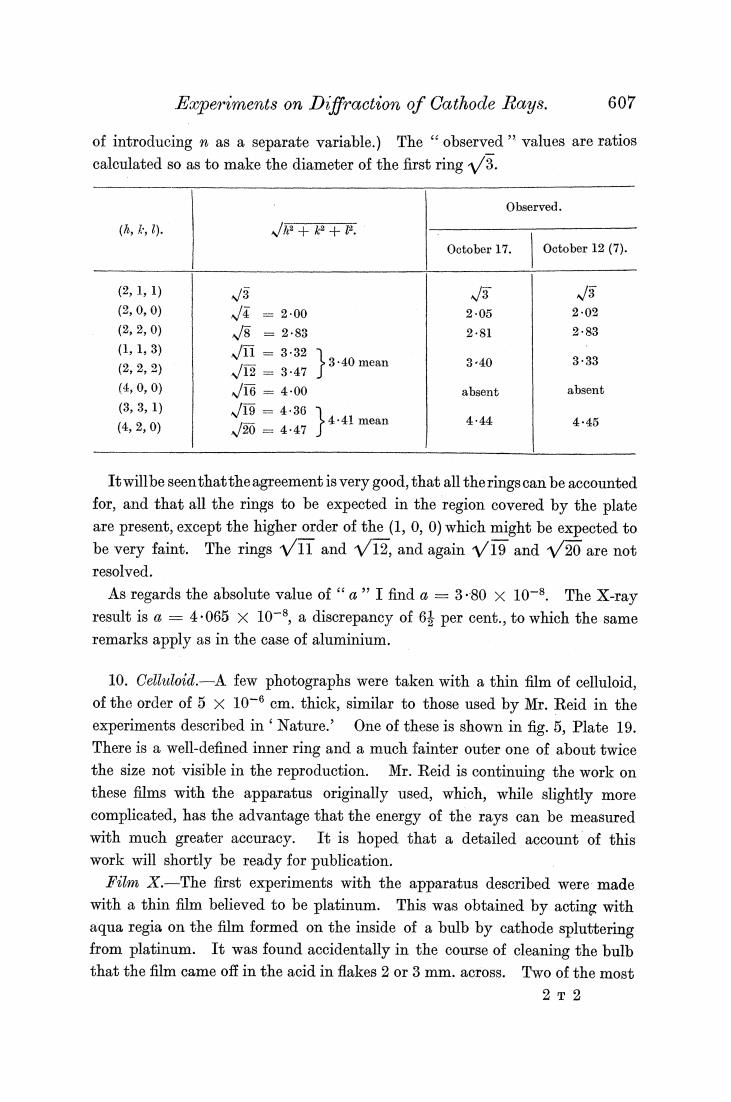
Experiments on Diffraction of Cathode Rays. 607 of introducing n as a separate variable.)The "observed"values are ratios calculated so as to make the diameter of the first ring3. Observed. (伍,) √++区 October 17. October 12 (7). (2,1,1) 3 5 (2,0,0) 在=2-00 205 202 (2,2,0) 8=288 281 283 (1,1,3) /=332 (2,2,2) /12=347 ,3·40mean 3:40 3-33 (4,0,0) √/16=400 absent absent (3,3,1) 19=436 (4,2,0) /20=447 4.41 mean 444 445 It willbe seen that the agreement is very good,that all the rings can be accounted for,and that all the rings to be expected in the region covered by the plate are present,except the higher order of the(1,0,0)which might be expected to be very faint.The rings V1l and√12,and again√19and√2o0 are not resolved. As regards the absolute value of“a”I find a=3·80×l0-8.TheX-ray result is a=4.065 x 10-8,a discrepancy of 6 per cent.,to which the same remarks apply as in the case of aluminium. 10.Celluloid.-A few photographs were taken with a thin film of celluloid, of the order of 5 x 10-6 cm.thick,similar to those used by Mr.Reid in the experiments described in'Nature.'One of these is shown in fig.5,Plate 19. There is a well-defined inner ring and a much fainter outer one of about twice the size not visible in the reproduction.Mr.Reid is continuing the work on these films with the apparatus originally used,which,while slightly more complicated,has the advantage that the energy of the rays can be measured with much greater accuracy.It is hoped that a detailed account of this work will shortly be ready for publication. Film X.-The first experiments with the apparatus described were made with a thin film believed to be platinum.This was obtained by acting with aqua regia on the film formed on the inside of a bulb by cathode spluttering from platinum.It was found accidentally in the course of cleaning the bulb that the film came off in the acid in flakes 2 or 3 mm.across.Two of the most 2T2

608 G.P.Thomson. transparent of these were mounted and tested.The thinnest showed a very well- marked inner ring*(fig.6,Plate 19)and a faint outer one (not reproducible) of about twice the size.The thicker film only showed the inner ring,and that rather faintly,but the size was the same.The inner ring of the thinner specimen varied in size with the voltage in the way now familiar,as shown in the following table:- Spark gap. Voltage. Diameter. DvV. mm. mm. ·3-25 12,000 185 203 45 16,100 15-8 200 7-0 23.200 12-9 196 0·25 29.600 11.9 205 13-0 39.900 100 200 14·75 44,400 97 204 Mean 201 The absolute size of the ring is,however,exactly half that to be expected from platinum taken as a face-centred cube of side 3.91 10-8.It is almost exactly that of the celluloid ring though the latter is rather sharper.It seems possible that these films were really due to some greasy substance present on the bulb (which was originally used for quite a different purpose).A film of this sub- stance would be selected as apparently the thinnest owing to its transparency. Attempts were made to obtain films of undoubted platinum by the same process, but they were unsuccessful as the films always broke while drying on the mount. This increases the probability that the films in question were not platinum. It is difficult to prepare thin platinum films by the methods that has been successful with gold and aluminium as I have been unable to obtain sufficiently thin foil to start with. Conclusions. The detailed agreement shown in these experiments with the de Broglie theory must,I think,be regarded as strong evidence in its favour.These means accepting the view that ordinary Newtonian mechanics(including the relativity modifications)are only a first approximation to the truth,bearing the same In this case the solarisation near the undeflected beam gives the appearance of an extra inner ring.A similar effect,less marked,can be seen in figs.3,4 and 5.These false rings can easily be distinguished in practice by taking photographs with varying exposures. Note added in Proof.-I have since been able to show that platinum films give the rings to be expected from the known crystal structure of the metal,see Nature,' December 3,p.802